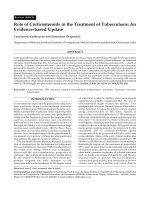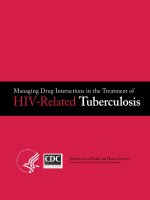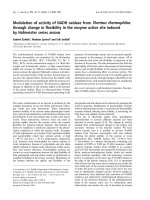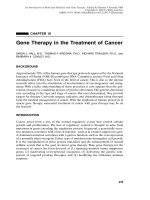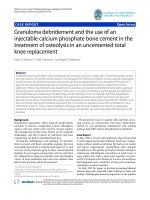Effects of anti malaria drug artesunate in the treatment of rhinovirus induced asthma exacerbation
Bạn đang xem bản rút gọn của tài liệu. Xem và tải ngay bản đầy đủ của tài liệu tại đây (2.65 MB, 172 trang )
ANTIMALARIAL DRUG ARTESUNATE IN THE
TREATMENT OF RHINOVIRUS-INDUCED ASTHMA
EXACERBATION
TAO LIN
(B.Sc)
A THESIS SUBMITTED FOR THE DEGREE OF
DOCTOR OF PHILOSOPHY
DEPARTMENT OF PHARMACOLOGY
NATIONAL UNIVERSITY OF SINGAPORE
2014
DECLARATION
I hereby declare that this thesis is my original work and it has been written by me in
its entirety.
I have duly acknowledged all the sources of information which have been used in the
thesis.
This thesis has also not been submitted for any degree in any university previously.
Tao Lin
22 Jan 2014
ii
ACKNOWLEDGEMENT
First and foremost, I would like to deeply thank my supervisor Professor Wong Wai-Shiu
Fred for his guidance and assistance through my Ph.D studies. Without his help and
encouragement, I definitely could not overcome so many obstacles in the projects. His
attitude and discipline will encourage me to continue the research work in the future.
I would also like to thank Professor Vincent TK Chow for his invaluable advice and efforts
on my research works.
I am grateful to Fera Goh, Khaing Nwe Win, Cheng Chang, Guan Shouping, Lah Lin Chin,
Winston Liao, Dong Jinrui, all colleagues in our lab, and friends who helped me in the
experiments, shared me with their experience, and supported me.
Thanks to National University of Singapore for providing me chances of studying in
Singapore.
Finally, I would like to extend my sincere gratitude to my parents, my sisters and all my best
friends for their endless love, support, and patience all the time.
iii
TABLE OF CONTENTS
ACKNOWLEDGEMENT................................................................................................... iii
TABLE OF CONTENTS .................................................................................................... iv
LIST OF TABLES ................................................................................................................ x
LIST OF FIGURES ............................................................................................................. xi
LIST OF ABBREVIATIONS ........................................................................................... xiii
1.
INTRODUCTION......................................................................................................... 1
1.1
Asthma .................................................................................................................... 2
1.1.1
Epidemiology and etiology and risk factors of asthma ................................... 2
1.1.2
Pathogenesis of asthma ................................................................................... 5
1.1.3
Asthma exacerbation ..................................................................................... 10
1.1.4
Role of NF-κB in allergic airway inflammation ........................................... 12
1.1.5
Therapeutic strategies in the treatment of asthma exacerbation ................... 14
1.2
Rhinovirus ............................................................................................................. 16
1.2.1
Biology of rhinovirus .................................................................................... 16
1.2.1.1
Transmission pathway............................................................................... 16
1.2.1.2
Structure of rhinovirus .............................................................................. 17
1.2.1.3
Live temperature of rhinovirus ................................................................. 21
1.2.1.4
Classification of rhinovirus ....................................................................... 22
1.2.1.5
A novel family member of rhinovirus family-HRV-C ............................. 24
iv
1.2.2
The interaction between rhinovirus and hosts............................................... 25
1.2.2.1
The entry and replication of rhinovirus into host cells ............................. 25
1.2.2.2
Host immune response to rhinovirus infection: ........................................ 27
1.2.2.3
The role of NF-κB in rhinovirus infection ................................................ 30
1.3
Artesunate ............................................................................................................. 34
1.3.1
Effects of artesunate ...................................................................................... 34
1.3.2
Pharmacokinetics and pharmacodynamics of artemisinins........................... 39
1.3.3
Side effects of artesunate .............................................................................. 40
1.4
NF-κB pathway ..................................................................................................... 41
1.4.1
Introduction to NF-κB pathway .................................................................... 41
1.4.2
Role of NF-κB inhibitors in virus infection and allergic airway inflammation
47
2.
RATIONALE & AIM ................................................................................................. 50
3.
METHODLOGY......................................................................................................... 53
3.1
Materials and Reagents ......................................................................................... 54
3.2
Cell culture ............................................................................................................ 54
3.3
Virus growth ......................................................................................................... 55
3.4
Rhinovirus titration ............................................................................................... 56
3.5
Virus purification .................................................................................................. 56
3.6
Viral replication test .............................................................................................. 57
3.7
Mouse.................................................................................................................... 57
v
3.8
Rhinovirus-induced lung inflammation mouse model .......................................... 58
3.9
Rhinovirus-induced asthma exacerbation mouse model ....................................... 58
3.10
Bronchoalveolar lavage fluid analysis .................................................................. 59
3.11
Total and differential cell count in BALF............................................................. 59
3.12
Reverse Transcriptase - Polymerase Chain Reaction (RT-PCR) .......................... 60
3.12.1
Reverse transcription .................................................................................... 61
3.12.2
Polymerase Chain Reaction (PCR) ............................................................... 61
3.12.3
Gel Electrophoresis ....................................................................................... 61
3.13
Histologic analysis ................................................................................................ 62
3.14
Airway hyperresponsivenss .................................................................................. 63
3.15
ELISA ................................................................................................................... 67
3.15.1
Tissue homogenization and supernatant harvest ........................................... 67
3.15.2
ELISA ........................................................................................................... 67
3.15.3
Serum total IgE ELISA ................................................................................. 67
3.16
NF-κB binding activity measurement ................................................................... 68
3.16.1 Nuclear protein extraction.................................................................................. 68
3.16.2 Western Bloting ................................................................................................. 69
3.16.3 NF-κB transcription factor assay ....................................................................... 69
3.17
4.
Statistic analysis .................................................................................................... 70
RESULTS .................................................................................................................... 72
vi
4.1
Rhinovirus induces the lung inflammation, mucus production, and inflammatory
gene expression in naive mice .......................................................................................... 73
4.2
Rhinoviruses exacerbate the lung inflammation in a HDM-induced allergic asthma
model 76
4.3
RV infection exacerbate the production of lung cytokines and chemokines. ....... 79
4.4
RV infection exacerbate the expression of inflammatory mediators .................... 79
4.5
Effects of RV infection on NF--κB translocation and transactivation .................. 80
4.6
Artesunate treatment reduces the exacerbation of recruitment of inflammatory
cells in mice with allerfic airway inflammation and inflammatory cell infiltration and
mucus production induced by RV infection. .................................................................... 87
4.7
Artesunate decreases the production of Th2 related cytokines and chemokines and
serum total IgE .................................................................................................................. 90
4.8
Artesunate inhibits the gene expression level of mucus gene Muc5ac ................. 93
4.9
Artesunate partially reversed AHR in RV infected and HDM treated mice ......... 93
4.10 Artesunate reduced the binding activity of NF-κB in RV infected and HDM treated
mice. 97
5.
DISCUSSION .............................................................................................................. 98
6.
REFERENCE ............................................................................................................ 114
vii
SUMMARY
Rhinovirus causes the majority of virus-induced asthma exacerbations. The purpose of this
study was to investigate the inflammatory mechanisms underlying this exacerbation
phenomenon. We combined the mouse model of allergic asthma (using house dust mite
[HDM] sensitization and challenge) and rhinovirus (RV) infection (intra-tracheal
inoculation with RV-1B, a minor group RV which binds to mouse airway epithelial cells).
Mice were sensitized and challenged with HDM or saline and infected with RV or PBS.
Bronchoalveolar lavage fluid and lung homogenates were tested for Th2 cytokines protein
levels and mRNA expression. Compared with saline/PBS treated mice, saline/RV treated
mice showed significant increase in airway neutrophils, lymphocytes, inflammatory cell
infiltration, mucus production and inflammatory chemokines mRNA expression. Compared
to HDM/PBS-treated mice, HDM/RV-treated mice showed significant increase in airway
neutrophils, eosinophils and lymphocytes. The HDM/RV group also showed higher protein
level of IL-4, IL-5, IL-13. Besides, the HDM/RV group showed higher mRNA level of
eotaxin-1, Muc-5AC. Taken together, we have demonstrated a model of RV-1B
exacerbation of the Th2 response in HDM-induced allergic asthma.
On the basis of the RV-induced asthma exacerbation mouse model, we test the effects of
anti-malarial drug Artesunate in the treatment of RV-induced asthma exacerbation.
Artesunate was administrated after RV infection via i.p. route. Control mice were injected
with DMSO. Lung homogenates were examined for inflammatory cells infiltration, and Th2
cytokine protein production and mRNA expressions. Airway hyper-responsiveness was
measured using direct airway resistance analysis. Compared with DMSO treatment group,
artesunate significantly inhibited rhinovirus –induced exacerbation in total inflammatory
cell count, eosinophil count and lymphocyte count. Artesunate also significantly inhibited
viii
rhinovirus-induced exacerbation in IL-4, IL-5, IL-13, IP-10 and Muc5AC mRNA
production. Meanwhile, artesunate singnificantly inhibited rhinovirus-induced total IgE
secretion and airway hyperresponsiveness.
At last, we also found that artesunate
significantly reduced the binding activity of NF-κB. Artesunate attenuated the exacerbation
of RV on asthma, and our findings implicated a potential value of artesunate in the treatment
of rhinovirus-induced asthma exacerbation. (This work was supported by a BMRC grant
09/1/21/19/595 to WSFW)
ix
LIST OF TABLES
Table Title
Page
Table 3-1 Targets and sequences for primer sets of RT-PCR ............................................... 71
x
LIST OF FIGURES
Figure Title
Page
Figure 1-1 Worldwide spread of asthma ................................................................................. 4
Figure 1-2 Pathogenesis of asthma (Adapted from Lemanske RF et al, 2010) ...................... 9
Figure 1-3 Structure of the genome of rhinovirus (Adapted from Jacobs et al. 2013) ......... 19
Figure 1-4 Structure of the rhinovirus capsid protein (adapted from Friedlander et al. 2005)
.............................................................................................................................................. 20
Figure 1-5 Host immune response to rhinovirus infection ................................................... 29
Figure 1-6 Role of rhinovirus infection in asthma exacerbation........................................... 33
Figure 1-7 Cultivar of the Chinese Herb Artemisia annua L. (qinhao or sweet wormwood)
and its active principle artemisinin (qinhaosu) ..................................................................... 37
Figure 1-8 Chemical structure of dihydroartemisinin (DHA) (adapted from Keating. 2012)
.............................................................................................................................................. 38
Figure 1-9 Family members of NF-κB proteins, IκB family, IKK family (Adapted from
Hayden and Ghosh. 2004)..................................................................................................... 42
Figure 1-10 The three kinds of NF-κB signal transduction pathways (Adapted from Hayden
and Ghosh. 2004) .................................................................................................................. 44
Figure 1-11 The different levels of action of various inhibitors of the NF-κB signal
transduction pathway. (Adapted from Gilmore et al. 2006) ................................................. 49
Figure 3- 1 The Buxco system for measurement of airway hyperresponsiveness ................ 66
Figure 4- 1 RV-1B exposure induces airway inflammation, mucus production, and
inflammatory genes mRNA expression ................................................................................ 75
xi
Figure 4- 2 Rhinovirus-1b exacerbates the recruitment of inflammatory cells, inflammatory
cell infiltration and mucus production in mice with allergic airway inflammation. ............. 78
Figure 4- 3 Rhinovirus infection further promoted in the production of cytokines and
chemokines in mouse with allergic airway inflammation..................................................... 81
Figure 4- 4 Effects of rhinovirus infection on HDM induced gene expression in allergic
airway inflammation mouse lung.......................................................................................... 83
Figure 4- 5 Effects of rhinovirus infection on NF-κB signaling pathway in mouse with
allergic airway inflammation ................................................................................................ 86
Figure 4- 6 Effects of Artesnuate on the exacerbated recruitment of inflammatory cells in
mice with allerfic airway inflammation and inflammatory cell infiltration and mucus
production. ............................................................................................................................ 89
Figure 4- 7 Effects of Artesunate treatment on cytokines and chemokines levels from
rhinovirus-induced lung homogenate.................................................................................... 92
Figure 4- 8 Effects of artesunate on RV induced MUC5AC mRNA expression in allergic
airway inflammation mouse lung.......................................................................................... 94
Figure 4- 9 Effects of artesunate on rhinovirus-induced AHR exacerbation ........................ 95
Figure 4- 10 Effect of artesnuate on rhinovirus-induced NF-κB signaling pathway ............ 97
xii
LIST OF ABBREVIATIONS
AHR
airway hyperresponsiveness
AMV
avian myeloblastosis virus
AP
alkaline phosphatase
ARTs
artesunate
BALF
bronchoalveolar lavage fluid
BCA
bicinchonic acid
BSA
bovine serum albumin
Cdyn
dynamic compliance
CMV
cytomegalovirus
COPD
chronic obstructive pulmonary disease
DMSO
dimethyl sulfoxide
ECL
enhanced chemiluminescent
Eos
eosinophil
FBS
fetal bovine serum
H&E
haemotoxylin and Eosin
HDM
house dust mite
HRP
horseradish peroxidase
HRV
human rhinovirus
ICAM-1
intercellular adhesion molecule-1
ICs
inhaled corticosteroids
xiii
IKK
IκB kinase
iNOS
inducible nitric oxide synthase
IP-10
Interferon gamma-induced protein 10
LDLRs
low density lipo-protein receptors
LFA-1
leukocyte function-associated antigen-1
LT
cysteiny l leukotriene
Lym
lymphocyte
Mac
macrophage
MC
mast cell
MCP-1
monocyte chemoattractant protein-1
MDA5
melanoma differentiation associated genes-5
NEMO
NF-κB essential modifier
Neu
neutrophil
NH4Cl
ammonium chloride
NKT cells
Natural killer T cells
NIK
NF-κB inducing kinase
NLS
nuclus location signal
NSAIDs
non-steroidal anti-inflammatory drugs
OVA
ovalbumin
PAMPs
pattern-associated molecular patterns
PBMC
peripheral blood mononuclear cell
PBS
phosphate buffered saline
xiv
PCR
polymerase chain reaction
PI3K
phosphoinositide-3-kinase
PRR
pathogen recognition receptor
PVDF
polyvinylidene difluoride
RANTES
regulated on activation, normal T cell
expressed and secreted
RIG-1
retinoic acid inducible protein
RHD
Rel homology domain
RI
airway resistance
RV
rhinovirus
SDS
sodium dodecyl sulfate
SDS-page
polyacrylamide gel electrophoresis
TAE
tris-acetate-EDTA
TBS
tris buffered saline
TEMED
tetramethylethylenediamine
TH2
T-helper type 2
TLRs
Toll-like receptors
TMB
tetramethylbenzidine
TSLP
thymic stromal lymphopoietin
VCAM-1
vascular cell adhesion molecule-1
VEGF
vascular endothelial growth factor
xv
xvi
1.INTRODUCTION
1
1.1 Asthma
1.1.1
Epidemiology and etiology and risk factors of asthma
Asthma is the most common chronic conditions affecting both children and adults. In the
whole world, 300 million people suffer from asthma and the prevalence of asthma still
continues to increase. (FIG.1-1) The prevalence of asthma is higher in western countries
compared with the Asian countries (Janson, Anto et al. 2001, Asher, Montefort et al. 2006)
and this trend keeps an increasing (Akinbami, Moorman et al. 2012). According to this
study, asthma prevalence is higher among children, females and those with family income
below the poverty level, and deferrers by race and ethnicity for the period 2008-2010.
The causes of asthma is complicated and yet to be clearly understood. Several evidence
have shown that genetic background is important (March, Sleiman et al. 2011). Many
genome-wide screenings of asthma and its associated traits have been carried out, and many
genetic linkages have been identified in different regions. These studies have identified 18
genes associated with allergy and asthma in 11 different populations. In particular, there are
consistently replicated regions on the long arms of chromosomes 2, 5, 6, 12 and 13
(Subbarao, Mandhane et al. 2009). In addition, the interaction between genetic and
environmental factors may also be important. Observations of migration populations and
Germany after reunification have strongly supported the role of local environmental factors,
including different types of allergens but likely many lifestyle factors as well, in
determining the degree of expression of asthma within genetically similar populations
(Cohen, Canino et al. 2007, Wang, Wong et al. 2008). According to these studies,
prevalence rates for asthma among children 13-14 years old were lowest for Chinese
children born and grew up in China, intermediate for Chinese children who had migrated
during their lifetime to Canada and highest for Chinese children who had been born in
2
Canada. These results strongly suggested gene-by-environment interactions. Host factors
can also contribute to asthma initiation and pathogenesis. For instance, stress, diet, nutrition,
socio-economic status and so on. Prenatal smoking has been consistently associated with
early childhood wheezing (Lewis, Richards et al. 1995, Stein, Holberg et al. 1999, Tariq,
Hakim et al. 2000).
Severe or uncontrolled asthma presents high socio-economic burden on a lot of countries.
The healthcare costs correlate positively with severity of asthma. The financial burden of
asthma costs up to $1, 300 per patient per year in the developed countries. In the United
States, 23 million people including seven million children suffer from asthma. In developing
countries like Vietnam, with gross product per capita of ﹩US1,411, the financial burden of
asthma estimates to be US$184 per patient per year. In India, the medication for an
asthmatic child can cost up to a third of the family’s income (Pawankar, Canonica et al.
2012).
In summary, the rising prevalence, high economic burden and mortality of asthma bog the
health-care system worldwide. However, the current drugs are only able to control the
symptoms. None of them are able to eliminate the disease. The major unmet in this area
include better management of the severe forms of the disease and development of curative
therapies. Therefore, more efforts are needed to put in this area to elucidate the pathogenesis
of asthma and to explore novel therapies for curing asthma.
3
Figure 1-1 Worldwide spread of asthma (adapted from Asthma: epidemiology, etiology
and risk factors)
4
1.1.2
Pathogenesis of asthma
Asthma is a heterogeneous disease which is composed of numerous distinct clinical
phenotypes. It is now accepted that asthma is a chronic inflammation condition, and
evidences of inflammation can be observed in mild, moderate and severe disease (Hamid
and Tulic 2009).
Many cells are involved in the immune and inflammatory response to allergens in asthma,
which include T cells, eosinophils, mast cells and neutrophils (FIG.1-2). The airway
epithelial cells are located at the interface between the host and the environment; therefore,
they are the first defense against the inhaled antigens. Epithelial cells express many pattern
recognition receptors (PRRs), which can be activated by the foreign antigens. This
activation leads to the activation of NF-κB signaling pathway, which results in the
production of various of chemokines and cytokines, such as IL-8 and IL-6 (Lambrecht and
Hammad 2012).
The bronchial epithelial cells also work as a physical barrier that prevents the access of
allergens to lung dendritic cells (Lambrecht and Hammad 2012).The integrity of airway
epithelia is maintained by apical tight junction and adherent junctions, which have the
ability to keep the cells together and maintain their apico-basal polarity (Xiao, Puddicombe
et al. 2011). Based on bronchial biopsy studies, the airways of subjects with asthma have
fragile epithelia (Lackie 1997). Exposure to these allergens induces disruption of epithelial
junctional proteins and the barrier function of airway epithelium. Once the integrity of the
epithelial cells has been destroyed, the inhaled allergens will be able to access to the
dendritc cells and initiate immune response (Lambrecht and Hammad 2012).
5
Blood and tissue eosinophila are hallmarks of asthma. Increased numbers of eosinophils in
the bronchial mucosa as well as in the bronchoalveolar lavage (BAL) and sputum are
consistent features of asthma, and BAL eosinophilia has been linked to development of the
late airway response and asthma severity (Jatakanon, Lim et al. 2000, Hamid and Tulic
2009). Eosinophils are able to release prestored granular proteins, including eosinophil
cationic protein, eosinophil peroxidase, and major basic protein. These potent cytotoxic
proteins have been found to be related to the epithelial damage observed in asthmatic
patients (Shamri, Xenakis et al. 2011). Eosinophils are also able to produce and release
oxygen redicals and lipid mediators, such as LTB4, LTC4 and PAF (Ohnishi, Miyahara et al.
2008). They are also capable of producing various kinds of cytokines and chemokines, such
as IL-1, 2, 3, 4, 5, 6, 10, 12 and 13, RANTES, MIP-1α and so on. In addition, eosinophils
also play an important role in airway remodeling via releasing of fibrogenic cytokines,
including TGF-β, IL-11, 17 and 25. Together these cytotoxic mediators determine the tissue
destructive potency of this inflammatory cell.
T cells constitute the majority of lung lymphocytes in normal individuals and can be found
in the airway, alveolar epithelium, and interstitium (Baraldo, Lokar Oliani et al. 2007). Once
activated, T cells can differentiate and proliferate into mature Th1, Th2, Th17, Th9, Treg,
natural killer (NK)T cells, or γδ T cells, depending on the cytokines released by antigen
presenting cells (Kaiko, Horvat et al. 2008). All the members in this family contribute to the
pathogenesis of asthma.
Macrophages contribute to inflammatory condition and are a critical cell type in the innate
and adaptive immune response. Macrophages can produce both pro- and anti-inflammatory
mediators, therefore, they act as either negative regulators or positive regulators, depending
6
on the environments (Bedoret, Wallemacq et al. 2009, Byers and Holtzman 2010, Yang,
Kumar et al. 2010).
The regulatory effects of macrophages in vivo are still unclear.
However, more and more evidence indicated that macrophages can positively regulate
asthma (Careau, Proulx et al. 2006). They found that macrophages are able to protect
alveolar macrophage-depleted sensitized rats that received sensitized alveolar macrophages
from developing airway hyperresponsiveness compared with that received unsensitized
alveolar macrophages.
These inflammatory and immune response are regulated by a number of cytokines and
chemokines, which are secreted from structural and inflammatory cells, such as the
eosinophils, bronchial epithelial cells and airway smooth muscle cells (ASM cells). These
inflammatory mediators can be divided into many subgroups. For instance, T cell-derived
molecules such as the so called-T helper-1 (Th1) cells (IL-2, IFN-γ, and IL-12), Th2 cells
(IL-4, 5 9, 13, and 25), Th3 or T regulatory cytokines (IL-10 and TGF-β) and TH17 cells
(IL-17A and 17F). Other cytokines include proinflammatory cytokines (IL-1β, 6, and 11,
TNF-α, and GM-CSF), growth factors, and chemokines.
Mucus is mainly comprised by the mucin glycoproteins, which is composed of up to 2% by
mass. Under normal conditions, airway mucus protects the host by trapping foreign debris,
bacteria and virus and can clear them by ciliary movement. However, under chronic
inflammation, such as asthma, the mucus could contribute to the pathogenesis of disease
(Rogers 2007). Gel forming secreted mucins, including MUC5AC and MUC5B are mainly
produced in airway goblet cells. The secretion of them is regulated by different mediators,
such as IL-13, which is the key regulator, TNF-α, epidermal growth factor receptor (EGFR)
(Takeyama, Fahy et al. 2001, Evans, Kim et al. 2009, Voynow and Rubin 2009, Lai and
7
Rogers 2010). Research indicated that the release of mucus are due to the activation of NFκB pathway(Evans, Kim et al. 2009). The production of mucus contributes to the airway
obstruction. Several studies have shown that mucus is also able to contribute to airway
hyperresponsiveness.
8
Figure 1-2 Pathogenesis of asthma (Adapted from Lemanske RF et al, 2010)
9



